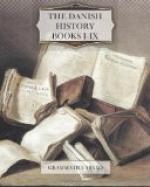There are a certain number of stories, which only occur in Saxo and in our other Northern sources with attributions, though they are of course legendary; such are:
The “Everlasting Battle” between Hedhin and Hogne, a legend connected with the great Brisinga-men story, and paralleled by the Cordelia-tale among the Britons.
The story of the “Children preserved” is not very clearly told, and Saxo seems to have euhemerized. It is evidently of the same type as the Lionel-Lancelot story in the Arthurian cycle. Two children, ordered to be killed, are saved by the slaying of other children in their place; and afterwards by their being kept and named as dogs; they come to their own and avenge their wrongs.
The “Journey to Hell” story is told of Eric, who goes to a far land to fetch a princess back, and is successful. It is apparently an adventure of Swipdag, if everyone had their rights. It is also told of Thorkill, whose adventures are rather of the “True Thomas” type.
The “Test of Endurance” by sitting between fires, and the relief of the tortured and patient hero by a kindly trick, is a variant of the famous Eddic Lays concerning Agnar.
The “Robbers of the Island”, evidently comes from an Icelandic source (cf. The historic “Holmveria Saga” and Icelandic folk-tales of later date), the incident of the hero slaying his slave, that the body might be mistaken for his, is archaic in tone; the powerful horse recalls Grani, Bayard, and even Sleipner; the dog which had once belonged to Unfoot (Ofote), the giant shepherd (cf. its analogues in old Welsh tales), is not quite assimilated or properly used in this story. It seems (as Dr. Rydberg suspects) a mythical story coloured by the Icelandic relater with memory full of the robber-hands of his own land.
The stratagem of “Starcad”, who tried even in death to slay his slayer, seems an integral part of the Starcad story; as much as the doom of three crimes which are to be the price for the threefold life that a triple man or giant should enjoy. The noose story in Starcad (cf. that told of Bicce in the Eormenric story), is also integral.
SAXO’S MYTHOLOGY.
No one has commented upon Saxo’s mythology with such brilliancy, such minute consideration, and such success as the Swedish scholar, Victor Rydberg. More than occasionally he is over-ingenious and over-anxious to reduce chaos to order; sometimes he almost loses his faithful reader in the maze he treads so easily and confidently, and sometimes he stumbles badly. But he has placed the whole subject on a fresh footing, and much that is to follow will be drawn from his “Teutonic Mythology” (cited here from the English version by Rasmus B. Anderson, London, 1889, as “T.M.").
Let us take first some of the incontestable results of his investigations that affect Saxo.
Sciold is the father of Gram in Saxo, and the son of Sceaf in other older authorities. Dr. Rydberg (97-101) forms the following equations for the Sciolding patriarchs:—




